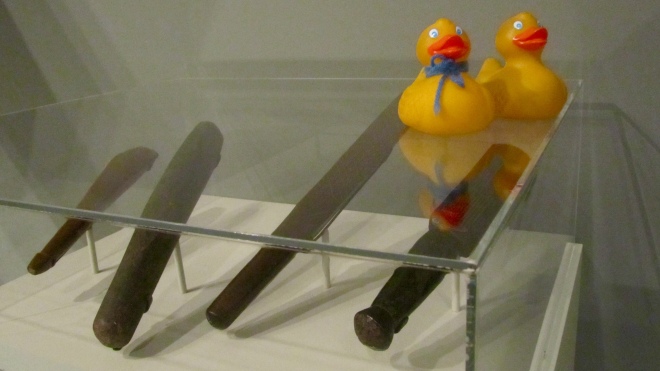Today we visited the third level of the Hamilton Building to view Oceanic Art.
We have been visiting the Art Museum frequently this spring. May in Denver this year has been very rainy, cloudy and cool. Many days in the 40 and 50 degree range. Flooding is a concern again. Even though we are ducks, we Colorado Ducks have become accustomed to warm, sunny days. The Oceanic Art focused on the Art of Bark Cloth. These belts from Papua New Guinea are gorgeous.
We ducks like them. Each belt is made of a single, springy coil of bark. The outer surface is engraved with elaborate geometric and figurative designs and further enhanced by rubbing with white or colored pigments. Young men wore these belts during ceremonies to indicate their status. The loincloth is great. A lot of work was done to create this.
This loincloth , from Papua New Guinea, was made around 1930 and is made of bark and paint. Look at this skirt.
It is also from Papua New Guinea and is made from bark, shell, feather and seed. Probably worn around 1900. Bark Cloth is really made from tree bark. Women pound the thin strips of bark with these beaters.
Women used beaters like these four, to pound and flatten narrow strips of bark into large and flatten pieces. Many of the beaters have patterns engraved on the them. During the beating process, the beaters leave designs on the bark cloth. Bark Cloth is so much a part of life that a postage stamp was issued to honor Bark Cloth.
WOW!! The stamp depicts Jacques Combet’s Making Tapa Cloth. This postage stamp is from the French territory Wallis and Futuna. This is the first full body mask that we ducks have seen. It is from the Asmat region, Papua New Guinea. This is a Jipae Mask from the mid 1980s.
The mask is made of bark, wood, paint, shell and feather. Among the Asmat, deceased male ancestors are respected, but also feared. Their uncontrolled spirits can cause harm to the community. Out of view of the women, skilled male artists create full body masks by intertwining narrow fibers made from the inner bark of the paper mulberry tree. Each mask is named for an ancestor. As they are worn and danced throughout the village, everyone has the opportunity to interact with them one last time. Look at these pieces of cloth.
Hard to remember that they started as tree bark. Masks like this sure are big.
This is a dance mask, from New Britain, Papua New Guinea. Made of bark, cane and paint, it was worn in the early 1900s. The artists stretch bark cloth over bamboo foundations in the shape of fantastical animals with large open mouths and protruding tongues. They paint oversized eyes on the front and bold geometric motifs on the back using bright red, back and white pigments. These masks serve multiple purposes as they are used in ceremonies to honor the dead and to celebrate. We were fascinated by the picture of people wearing these masks in New Guinea
to celebrate a bountiful harvest. When you visit the Denver Art Museum, we hope you look at the Oceanic Art display. They have videos of people making bark cloth. We think you will find it fascinating also. For more information visit www.DenverArtMuseum.org See you there!










